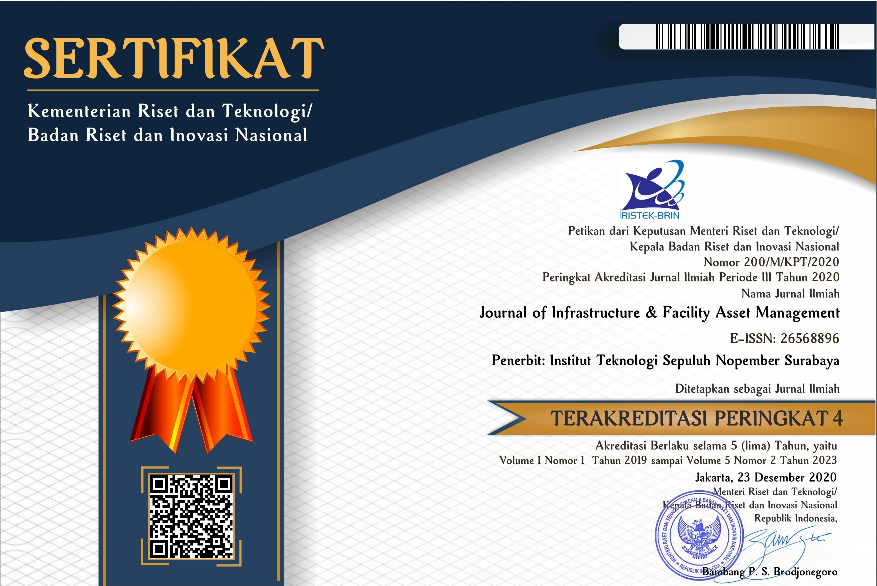The Effect of Addition RAP as Quality Improved for Hot Paved Mixtures
Abstract
Reclaimed Asphalt Pavement (RAP) is the residual waste of pavement that has been damaged or has reached the end of the pavement by using a Cold Milling Machine (CMM). The old aggregate undergoes gradation changes due to traffic loads and weather effects so the gradation is not following the ideal gradation plan. The addition of natural aggregates aims to improve the grading envelope to meet the upper and lower limits of the AC-BC layer requirements. This study aims to determine the optimal composition of the RAP material in terms of Marshall characteristics. The use of RAP material variations is 30%, 40%, and 50% of the total composition of the mixture. This study refers to the 2018 Bina Marga specifications and the Marshall method for laboratory testing. The research steps consisted of material extraction testing, aggregate and asphalt properties, sieve analysis tests for mixed grading envelopes, and Marshall tests.
The results of this study are the characteristics of the mixture in terms of Marshall stability for the composition of RAP 30%, the stability value is 1433.3 Kg, RAP 40% is 1621.7 Kg, and RAP 50% is 1920.8 Kg. The greater the composition of the RAP, the greater the stability value, which shows the strong mixed nature of holding vehicle traffic loadsFull Text:
PDFReferences
Bina Marga. (2010). Spesifikasi Umum Bina Marga Tahun 2010 Revisi 3. Direktorat Jenderal Bina Marga Kementrian Pekerjaan Umum. Jakarta.
Budianto, H. (2009). Menuju Jalan yang Andal. PT. Cakra Daya Sakti. Surabaya.
Departemen Pemukiman dan Prasarana Wilayah. (2002). Manual Pekerjaan Campuran Beraspal Panas. Direktorat Jenderal Prasarana Wilayah. Jakarta.
Falevi, R. (2012). Optimalisasi Penggunaan Reclaimed Asphalt Pavement (RAP) sebagai Bahan Campuran Beraspal Panas (Asphaltic Concrete) Tipe AC-Wearing Course (ACWC) Gradasi Halus dengan Menggunakan Aspal Pen 60-70 Variasi Abrasi Agregat Baru (Studi Kasus Jalan Nasional Pandaan – Malang). Tesis Pasca Sarjana. Institut Teknologi Sepuluh Nopember Surabaya.
Handayani, R. (2016). “Analisa Penggunaan Reclaimed Asphalt Pavement (RAP) sebagai Bahan Campuran Beraspal Panas Tipe Asphalt Concrete-Binder Course (ACBC) dengan Menggunakan Fly Ash (Studi Kasus Ruas Jalan Taman Waru)”. Tesis Pasca Sarjana. Institut Teknologi Sepuluh Nopember Surabaya.
Herawati, N., Soemitro, R.A.A., Budianto, H. (2012). “Analisis Penentuan Komposisi Optimal Penggunaan Reclaimed Asphalt Pavement (RAP) sebagai Bahan Campuran Beraspal Panas (Asphaltic Concrete) Menggunakan Aspal Modifikasi (Studi Kasus Jalan Pilang – Probolinggo)”. Prosiding Seminar Nasional Aplikasi Teknologi Prasarana Wilayah (ATPW) Surabaya, 11 Juli 2012. ISSN 2301-6752, Material Bahan Bangunan dan Konstruksi, hal. F-1.
Kusmarini, E.P., Soemitro, R.A.A., Budianto, H. (2012). “Analisis Penggunaan Reclaimed Asphalt Pavement (RAP) dan Aspal Pen 60 – 70 sebagai Bahan Campuran Beraspal Panas (Asphaltic Concrete ) (Studi Kasus Ruas Jalan Gemekan – Jombang dan Pandaan – Malang)”. Prosiding Seminar Nasional Aplikasi Teknologi Prasarana Wilayah (ATPW) Surabaya, 11 Juli 2012, ISSN 2301-6752, Material Bahan Bangunan dan Konstruksi, hal. F-5 – F-10.
NAPA (1996). Hot Mix Asphalt Materials Mixture Design and Construction. National Asphalt Pavement Association. Education Foundation. Maryland
Pradyumna, T Anil. Mittal, Abhishek, Jain, P.K. (2013). “Characterization of Reclaimed Asphalt Pavement (RAP) for Use in Bituminous Road Construction”. Procedia-Social and Behavioral Sciences 104, pp. 1149-1157.
Shen, J., Amirkhanian, S., Aune, J.M. (2007). “Effects of Rejuvenation Agents of Superpave Mixtures Containing Reclaimed Asphalt Pavement”. Journal of Materials in Civil Engineering. ASCE. May. 2007.
Sujiartono, A. (2014). Optimalisasi Penggunaan Reclaimed Asphalt Pavement (RAP) sebagai sebagai Bahan Campuran Beraspal Panas (Asphaltic Concrete) Tipe AC-Binder Course (AC-BC) dan AC-Base Course (AC-Base) dengan Menggunakan Aspal Modifikasi Asbuton (BNA-Blend) (Studi Kasus Jalan Nasional Pilang-Probolinggo). Tesis Pasca Sarjana. Institut Teknologi Sepuluh Nopember Surabaya.
Sukirman, S. (1995). Perkerasan Lentur Jalan Raya. Penerbit Nova. Bandung.
Suprayitno, H. & Soemitro, R.A.A. (2018). ”Preliminary Reflexion on Basic Principle of Infrastructure Asset Management”. Jurnal Manajemen Aset Infrastruktur & Fasilitas – JMAIF 2(1) Maret 2018
Suwantoro (2010). Optimalisasi Penggunaan Material Hasil Cold Milling untuk Daur Ulang Lapisan Perkerasan Beton Aspal Tipe AC (Asphaltic Concrete). Tesis Pasca Sarjana. Institut Teknologi Sepuluh Nopember Surabaya.
TRB (2011). A Manual for Design of Hot Mix Asphalt with Commentary. National Cooperative Highway Research Program. NCHRP Report 673, Transportation Research Board. Washington DC.
Wibowo, H.W. (2012). Optimalisasi Penggunaan Reclaimed Asphalt Pavement (RAP) sebagai Material Campuran pada Asphaltic Concrete Tipe AC–BC dan AC–Base dengan Pen 60-70 (Studi Kasus Jalan Nasional Pandaan – Malang). Tesis Pasca Sarjana. Institut Teknologi Sepuluh Nopember Surabaya.
Widayanti, A., Soemitro, R.A.A., Ekaputri, J.J., Suprayitno, H. (2013). “Karakteristik Material Pembentuk Reclaimed Asphalt dari Jalan Nasional di Provinsi Jawa Timur”, Jurnal Manajemen Aset Infrastruktur dan Fasilitas, Volume 1, No. 1, Desember 2017, ISSN 2615-1847, halaman 11-22.
Widger, A., Skilnick, F., Zabolotnii, E. (2012). Utilization of Recycled Asphalt in Cold Mixes and Cold In-Place Recycling Processes-Guidelines. Engineer-In-Training Clifton Associated Ltd. Communities of Tomorrow. Leveraged Municipal Innovation Fund.
Xiao, F., Amirkhanian, S.N., Shen, J., Putman, B. (2009). “Influences of Crumb Rubber Size and Type on Reclaimed Asphalt Pavement (RAP) Mixtures”. Construction and Building Materials 23, hal.1028-1034.
Xiao, F., Amirkhanian, Serji, J., Hsein, C. (2007). “Rutting Resistance of Rubberized Asphalt Concrete Pavements Containing Reclaimed Asphalt Pavement Mixtures”. Journal of Materials in Civil Engineering, ASCE, June 2007, pp. 475-483.
DOI: http://dx.doi.org/10.12962%2Fjifam.v4i1.14298
Refbacks
- There are currently no refbacks.
Visitor :
Flag Counter

Journal Of Infrastructure & Facility Asset Management by Institut Teknologi Sepuluh Nopember is licensed under a Creative Commons Attribution-ShareAlike 4.0 International License.





